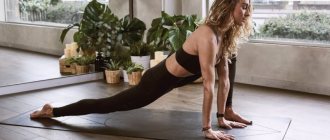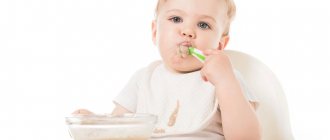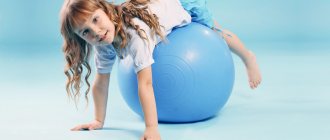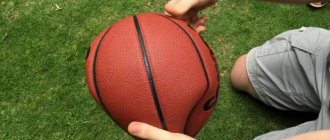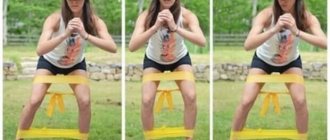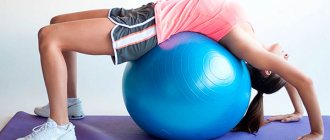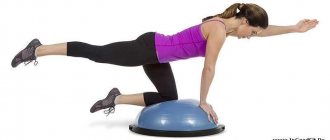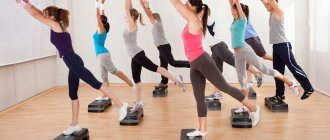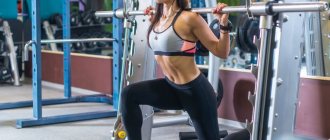Additional developmental children's fitness program "Zdrivers"
Content
1. Explanatory note…………………………………………..……….. 2-8 pages.
2. Main part……………………………………………………………8-11 pages.
2. 1. Structure and main directions of program implementation...8-9 pages.
2.2. Structure of lessons……………………………………………………9-10 pages.
2.3. Diagnosis of physical fitness………………………..10-11 pp.
3. Contents of program material…………………………………11 pages.
3.1. Contents of the program material (1st year of study)………11-12 pages.
3.2. Contents of the program material (2nd year of study)……… 12-14 pages.
3.3.Content of program material (3rd year of study)………….14-17 pages.
3.4. Contents of the program material (4th year of study)…………..17-20 pp.
4. Conditions for the implementation of the program……………………………………………………………20-21 pages.
Used literature…………….……………………………………22 pages.
Applications…………………………………….…………………….………………
1. Explanatory note
The program is developed based on the example program "Children's Fitness".
This program is an additional education program in children's fitness for preschool children. The program is aimed at strengthening the health of preschool children, ensuring optimal physical activity of children, increasing the level of attractiveness of physical education classes through introduction to children's fitness.
Currently, there is a fact of lag, delay, violation, deviation, non-compliance with standards in the development of children of early and preschool age. Especially many deviations occur in the state of the nervous system and musculoskeletal system. Unfortunately, family education is mainly focused on the development of the child’s intelligence and cognitive sphere, while insufficient attention is paid to the development of motor qualities and skills of a preschool child, and optimization of his motor mode. In this regard, the main goal of physical education in a preschool institution is to satisfy the natural biological need of children for movement, achieving an optimal level of health and comprehensive motor development. And achieving this goal is impossible without a constant search for new effective and diverse forms of physical education and health work.
A lot of new and interesting things can be added to the physical activity of preschoolers thanks to the use of modern fitness technologies. One of these areas is children's fitness.
Children's fitness is a well-chosen program taking into account the child's age, level of development and physical fitness, and includes training systems adapted for the child's body using the latest equipment and equipment.
The main goal of the program is to improve the health and increase physical activity of preschoolers through children's fitness classes.
Program objectives:
- Optimize the growth and development of the musculoskeletal system (formation of correct posture, prevention of flat feet). Develop basic physical qualities (strength, flexibility, endurance, speed, coordination). Promote functional improvement of the respiratory, circulatory, cardiovascular and nervous systems of the body. Create conditions for a positive psycho-emotional state of children. Develop a sense of rhythm and musical memory. Develop the creative abilities of students. Increase interest in physical education.
Regulatory and legal basis of the Program:
Federal Law - Federal Law “On Education in the Russian Federation”. Law of the Russian Federation “On Basic Guarantees of the Rights of the Child of the Russian Federation” No. 000 - Federal Law of 01.01.2001. Fundamentals of the legislation of the Russian Federation “On the protection of the health of citizens” No. 000 - 1 of 01.01.2001. Resolution of the Chief State Sanitary Doctor of the Russian Federation “On approval of SanPiN 2.4.1.3049-13” sanitary and epidemiological requirements for the structure, content and organization of the operating mode of preschool educational organizations” Order of the Ministry of Education and Science of Russia “On approval of the Procedure for organizing and implementing educational activities for basic general education programs - educational preschool education programs." Order of the Ministry of Education and Science of Russia “On approval of the Federal State Educational Standard for Preschool Education.”
Principles of program implementation.
The implementation of the program is based on the following principles:
- The principle of accessibility is the use of exercises in accordance with the age characteristics of children and the level of development of physical fitness. The principle of individuality is the implementation of an individual approach to children of different ages, gender, motor training and physical development. The principle of systematicity and consistency is the need for continuity and regularity in the formation of motor skills in children that are adequate to the characteristics of their development during preschool age; gradual presentation of material from simple to complex. The principle of absent-mindedness is focusing on different muscle groups. The principle of consciousness and activity is the formation in children of a sustainable interest in mastering new movements, instilling self-control skills, developing consciousness, initiative, and creativity. The principle of effectiveness and assurance is the realization of children’s rights to receive the necessary help and support. Guaranteed positive results regardless of the age and level of physical development of children.
The main methods used in the implementation of the program:
A visual method that provides the brightness of sensory perception and motor sensations necessary for the child to develop the most complete and specific idea of movement, activating the development of his sensory abilities;
A verbal method addressed to the consciousness of children, helping to comprehend the task assigned to them and, in connection with this, consciously perform motor exercises, playing a large role in mastering the content and structure of exercises, and their independent application in various situations;
A practical method associated with the practical motor activity of children, providing an effective test of the correct perception of movement using their own muscle-motor sensations. Practical methods are characterized by full or partial regulation, conducting exercises in a playful (figurative) form, and using elements of competition.
Regulation of exercises is necessary for repeated repetition of motor actions or their individual elements. It is characterized by a specific sequence of movements, compliance with normalized load and rest, and their specific alternation. All this contributes to better development of motor skills and abilities, maintaining the optimal functional state of the child’s body and psyche.
Method of analogies. The training program widely uses the method of analogies with the animal and plant world (image, pose, motor imitation), where the teacher-director, using game attributes, image, activates the work of the right hemisphere of the child’s brain, his spatial-figurative thinking, promoting the release of hidden creative possibilities of the subconscious.
The gaming method, which is close to the leading activity of preschool children, is the most specific and emotionally effective in working with them, taking into account the elements of visual-figurative and visual-effective thinking. It makes it possible to simultaneously improve a variety of motor skills, independence of action, quick response to changing conditions, and manifestation of creative initiative.
In the process of play activities, children develop moral and volitional qualities, develop cognitive powers, and gain experience in behavior and orientation in a group environment.
The competitive method in the process of teaching preschool children can be used subject to pedagogical guidance. This method is used to improve already acquired motor skills. A prerequisite for the competition is that it matches the children’s physical strength, education
Formation of groups
The educational and training process is designed for the period of training of preschool children in a general education institution - 4 years.
Study groups in the Children's Fitness department are staffed in accordance with the age, health status and preparedness of the students.
The children's fitness group of the 1st year of study is formed from children 3 - 4 years old of the second junior group of kindergarten who have a doctor's clearance. The minimum group size is 15 people. Number of training sessions per week – 1, duration of training – 20 minutes. The duration of the lesson for each child varies depending on his individual psychophysiological and physical condition.
The children's fitness group of the 2nd year of study is formed from children 4–5 years old in the second junior group of kindergarten who have a doctor's clearance. The minimum group size is 15 people. Number of training sessions per week – 1, duration of training – 20 minutes. The duration of the lesson for each child varies depending on his individual psychophysiological and physical condition.
The children's fitness group of the 3rd year of study is formed from children aged 5–6 years of the second junior group of kindergarten who have a doctor's clearance. The minimum group size is 15 people. Number of training sessions per week – 1, duration of training – 25 minutes. The duration of the lesson for each child varies depending on his individual psychophysiological and physical condition.
The children's fitness group of the 4th year of study is formed from children 6-7 years old of the second junior group of kindergarten who have a doctor's clearance. The minimum group size is 15 people. Number of training sessions per week – 1, duration of training – 30 minutes. The duration of the lesson for each child varies depending on his individual psychophysiological and physical condition.
Expected result:
1.Increasing the level of physical education, health, and preventive work in preschool educational institutions.
2.Increasing the level of physical and mental health of children.
3.Formation in children of the desire for self-knowledge and physical improvement.
4.Expansion of motor experience, satisfaction of children’s needs for movement, improvement of body systems and functions, preservation and strengthening of health.
5.Development of spatial coordination and rhythmic abilities; formation of skills to voluntarily control the body, regulate speech, emotions.
2. Main part
2. 1. Structure and main directions of program implementation
Preparation in children's fitness includes theoretical, physical, technical, choreographic, psychological and professional training. The distribution of time in the curriculum for the main sections of training by year of study is carried out in accordance with the specific objectives of long-term training.
Educational and thematic plan for children's fitness classes
for preschoolers 3 – 7 years old.
| № | Program section | 1st year training | 2nd year training | 3rd year training | 4th year training | ||||
| Number of hours | % Ratio | Number of hours | % Ratio | Number of hours | % Ratio | Number of hours | % Ratio | ||
| 1. | Basic knowledge | during classes | |||||||
| 2. | Beast aerobics | 3.50 | 40 | ——— | ——— | ——— | ——— | ——— | ——— |
| 3. | Classic aerobics | ——— | ——— | 4.40 | 40 | 2.20 | 16 | 2.20 | 16 |
| 4. | Fitball gymnastics | ——— | ——— | ——— | ——— | 2.20 | 16 | 2.20 | 16 |
| 5. | Choreography | 40 | 7.5 | 40 | 6 | 40 | 5 | 40 | 5 |
| 6. | Elements of acrobatics and gymnastics | 30 | 5 | 60 | 8 | 60 | 7 | 60 | 60 |
| 7. | Work on simulators | 3.10 | 35 | 3.40 | 32 | 6.20 | 44 | 6.20 | 44 |
| 8. | Yoga elements | 40 | 7.5 | 40 | 6 | 40 | 5 | 430 | 5 |
| 9. | Game stretching | 30 | 5 | 60 | 8 | 60 | 7 | 60 | 7 |
| TOTAL | 9.20 | 11.40 | 14 | 14 |
2.2. Structure of classes.
The structure of classes is developed in accordance with the requirements of physiology and hygiene of physical exercise and is determined by the patterns of performance and fatigue of the child’s body during physical activity. The parts of the lesson naturally flow into one another. A typical lesson structure includes 3 parts.
1. Preparatory part. The main task of this part of the lesson is the clear organization of children,
focusing their attention, forming an emotional and psychological mood. The content is characterized by drill and order exercises, various types of walking, running, jumping, as well as pre-learned and well-mastered aerobics, step aerobics or musical and rhythmic compositions.
2. Main part. The goal of the main part of the lesson is to master the main, vital and special skills that contribute to the development of the “Children’s Fitness” discipline. The most typical for this part of the lesson are not only such traditional exercises as walking, running, jumping, balance exercises, breathing exercises, but also special exercises characterizing such types as classical aerobics, fitball - aerobics, strength training (exercises with objects: dumbbells , tourniquets, expanders), exercises on a step platform, athletic balls, etc. In addition to exercises for developing general endurance, muscle memory, musicality, task exercises are used that develop creative thinking.
3. Final part. The objectives of this part are to complete the work by gradually reducing the load on the body and bring the children into a calmer state. The main remedies are slow walking, exercises to restore breathing and relaxation.
2.3. Diagnosis of physical fitness
Test to determine speed qualities: run 10m, 20m, 30m from the start.
It is carried out on a treadmill from a high start. On the command “march”, children run from the “start” line to the “finish” line.
Test to determine speed-strength qualities: standing long jump.
Three attempts are given and the best result is recorded.
Test to determine coordination abilities: static balance (light version of the Romberg test).
The child takes the starting position: the toe of the leg standing behind is closely adjacent to the heel of the one standing in front - and at the same time tries to maintain balance. The test taker completes the task with his eyes open. Balance time
Recorded with a stopwatch. Of the two attempts, the best result is recorded.
Strength endurance test: lifting the body from a supine position. The person being tested lies on the mat on his back, knees bent, feet on the floor, arms crossed over his chest. At the command “Start!” the child raises his body 30 degrees from the floor and lies down again. The number of ascents is counted. Raising the body is considered correctly performed if the lower back is pressed to the floor, the chin is not pressed to the chest, the feet do not come off the floor (hold the feet), inhale when lifting, and exhale when lowering.
Test to determine strength: flexion-extension of the arms in a lying position.
The legs, torso and head remain in one line. The angle of flexion at the elbow joint is 90.
Flexibility test: from the starting position, sit on the floor with your feet apart, shoulder-width apart. The heels are at the zero level. The child performs a maximum forward bend and holds for 3 seconds.
3. Contents of program material
3.1. Contents of the program material (1st year of study)
1. Basic knowledge.
Theoretical training is carried out in the form of conversations or lectures directly during classes.
The explanation of the theoretical material is adapted for children's age.
Theoretical training includes the following topics:
- History of development and current state of fitness aerobics. Hygienic requirements for fitness practitioners. Prevention of morbidity and injury in fitness. The influence of physical exercise on the athlete's body. Basics of musical literacy.
2. Beast - aerobics.
3. Choreography.
Elements of classical dance:
- Hand positions (first, second, third, preparatory). Soft movement of the brushes. Wave-like movement of the hands.
- Leg position (first, second, third, sixth)
Dance steps and elements of folk dance:
- A soft step from the toe forward, to the side, back. An additional step forward, to the side, back.
4. Elements of acrobatics and gymnastics.
- Sitting on your heels, lying down, lying down behind you. Grouping, rolling in a group. Bends while sitting; bends in gray legs apart.
5. Work on simulators.
- Medball. Rubber expander. Trampoline.
6. Elements of yoga.
Passive relaxation after straining individual muscle groups. Passive rocking of a relaxed part of the body. Shaking. Segmental relaxation.
Yoga asanas. In a sitting position: butterfly pose, half lotus pose. Lying down: child pose, snake pose, dog pose. For balance: tree pose.
7. Stretching.
3.2. Contents of the program material (2nd year of study)
1.Fundamentals of knowledge.
Theoretical training is carried out in the form of conversations or lectures directly during classes.
The explanation of the theoretical material is adapted for children's age.
Theoretical training includes the following topics:
- History of development and current state of fitness aerobics. Hygienic requirements for fitness practitioners. Prevention of morbidity and injury in fitness. The influence of physical exercise on the athlete's body. Basics of musical literacy.
2. Classic aerobics.
Marching simple steps (simple - no change of foot):
- March - walking in place. Basicstep - right step forward, left step, right step back, left step. V - step - step the right one forward - to the side diagonally, step the left one forward - towards the diagonal, step the right one back, put the left one.
Added simple steps (simple - without changing feet):
- Steptouch - step with the right foot to the right, place the left foot, touching the toe near the right (the heel does not drop), step with the left foot to the left, place the right foot, touching the toe near the left (the heel is fully lowered). Kneeup – step towards the right – lifting the knee with the left, step towards the left – lifting the knee with the right. Curl - step towards the right - overlap with the left, step towards the left - overlap with the right. Kick – step towards the right – lifting the left forward by 45 (“kick”), step towards the left – lifting the right forward by 45 (“punch”). Liftside - step towards the right - lifting the left to the side by 45 ("strike"), step towards the left - lifting the right to the side by 45 ("strike"). Openstep – right step to the side – left on the toe – left step to the side – right on the toe.
Side steps with change of foot (Alternative):
- Grapevine - step with the right to the side, with the left - crosswise back, with the right foot to the side, placing the left one.
3. Choreography.
Elements of classical dance:
Hand positions (first, second, third, preparatory). Soft movement of the brushes. Wave-like movement of the hands.
- Leg position first, second, third, sixth. Half squats in the first, second, third positions. Calf raise.
Dance steps and elements of folk dance:
- A soft step from the toe forward, to the side, back. An additional step forward, to the side, back. Variable step forward, sideways, backwards.
4. Elements of acrobatics and gymnastics.
- Sitting on your heels, lying down, lying down behind you. Grouping; grouping rifts; shoulder blade stand; stand on your shoulder blades with your legs bent. Bends while sitting; bending in gray legs apart; "Boat" on the stomach.
5. Work on simulators.
- Exercise bike. Trampoline. Medball. Rubber expander. Health disk. Strength trainer. Mini stepper. Roller.
6. Elements of yoga.
Passive relaxation after straining individual muscle groups. Passive rocking of a relaxed part of the body. Shaking. Segmental relaxation.
Yoga asanas. In a sitting position: butterfly pose, half lotus pose, lotus pose. Lying down: child pose, snake pose, dog pose. For balance: tree pose.
Restoring breathing after physical activity.
7. Stretching.
3.3. Contents of the program material (3rd year of study)
1. Basic knowledge.
Theoretical training is carried out in the form of conversations or lectures directly during classes.
The explanation of the theoretical material is adapted for children's age.
Theoretical training includes the following topics:
- History of development and current state of fitness aerobics. Hygienic requirements for fitness practitioners. Prevention of morbidity and injury in fitness. The influence of physical exercise on the athlete's body. Basics of musical literacy.
2. Classic aerobics.
Marching simple steps (simple - no change of foot):
- March - walking in place. Basicstep - right step forward, left step, right step back, left step. V - step - right step forward - to the side diagonally, left step forward - to the side
diagonals, step back with the right one, put the left one in.
- Mambo – right step forward, left step in place, right step back, left step in place. Cross – step forward with the right – cross with the left – back with the right – left to the side in and. P.
Added simple steps (simple - without changing feet):
- Steptouch - step with the right foot to the right, place the left foot, touching the toe near the right (the heel does not fall), step with the left foot to the left, place the right foot, touching the toe near the left (the heel does not fall to the floor). Kneeup – step towards the right – lifting the knee with the left, step towards the left – lifting the knee with the right. Curl - step towards the right - overlap with the left, step towards the left - overlap with the right. Kick – step towards the right – lifting the left forward by 45 (“kick”), step towards the left – lifting the right forward by 45 (“punch”). Liftside - step towards the right - lifting the left to the side by 45 ("strike"), step towards the left - lifting the right to the side by 45 ("strike"). Openstep – right step to the side – left on the toe – left step to the side – right on the toe.
Side steps with change of foot (Alternative):
- Grapevine - step with the right to the side, with the left - crosswise back, with the right foot to the side, placing the left one. Doublesteptouch - two additional steps to the side - right step to the side, left step, right step to the side, left step, right step to the side, right to the toe.
3. Choreography.
Elements of classical dance:
- Hand positions (first, second, third, preparatory). Soft movement of the brushes. Wave-like movement of the hands. Leg position first, second, third, sixth. Half squats in the first, second, third positions. Calf raise. Putting your feet on your toes forward, to the side, back from positions 1 and 3 (“cross”).
Dance steps and elements of folk dance:
- A soft step from the toe forward, to the side, back. An additional step forward, to the side, back. Variable step forward, sideways, backwards. Gallop stride. Combination of steps in dance combinations.
4. Fitball - gymnastics.
5. Elements of acrobatics and gymnastics.
- Sitting on your heels, lying down, lying down behind you. Grouping; grouping rifts; shoulder blade stand; stand on the shoulder blades, legs bent; bridge with and without assistance from a supine position. Bends while sitting; bending in gray legs apart; “Boat” on the stomach; lying on your stomach, bend over and grab your shins with your hands (“Basket”); combination of mastered elements.
6. Work on simulators.
- Exercise bike. Trampoline. Medball. Rubber expander. Health disk. Strength trainer. Mini stepper. Roller.
7. Elements of yoga.
Passive relaxation after straining individual muscle groups. Passive rocking of a relaxed part of the body. Shaking. Segmental relaxation.
Yoga asanas. In a sitting position: butterfly pose, half lotus pose, lotus pose, legs behind the head pose. Lying down: child pose, snake pose, dog pose, dead pose. For balance: tree pose.
Training in diaphragmatic breathing, chest breathing, mixed breathing, followed by constant reinforcement and improvement. Restoring breathing after physical activity.
1. Stretching.
3.4. Contents of the program material (4th year of study)
1. Basic knowledge.
Theoretical training is carried out in the form of conversations or lectures directly during classes.
The explanation of the theoretical material is adapted for children's age.
Theoretical training includes the following topics:
- History of development and current state of fitness aerobics. Hygienic requirements for fitness practitioners. Prevention of morbidity and injury in fitness. The influence of physical exercise on the athlete's body. Basics of musical literacy.
2. Classic aerobics.
Marching simple steps (simple - no change of foot):
- March - walking in place.
- Basicstep - right step forward, left step, right step back, left step. V - step - right step forward - to the side diagonally, left step forward - to the side
diagonals, step back with the right one, put the left one in.
- Mambo – right step forward, left step in place, right step back, left step in place. Cross – step forward with the right – cross with the left – back with the right – left to the side in and. P.
Added simple steps (simple - without changing feet):
- Steptouch - step with the right foot to the right, place the left foot, touching the toe near the right (the heel does not fall), step with the left foot to the left, place the right foot, touching the toe near the left (the heel does not fall to the floor). Kneeup – step towards the right – lifting the knee with the left, step towards the left – lifting the knee with the right. Curl - step towards the right - overlap with the left, step towards the left - overlap with the right. Kick – step towards the right – lifting the left forward by 45 (“kick”), step towards the left – lifting the right forward by 45 (“punch”). Liftside - step towards the right - lifting the left to the side by 45 ("strike"), step towards the left - lifting the right to the side by 45 ("strike"). Openstep – right step to the side – left on the toe – left step to the side – right on the toe. Heeltouch - step towards the right - left to the side on the heel, step towards the left - right to the side on the heel. Lunge - lunge on the left, right to the side on the toe - place the right, lunge on the right, left to the side on the toe - place the left.
Side steps with change of foot (Alternative):
- Grapevine - step with the right to the side, with the left - crosswise back, with the right foot to the side, placing the left one. Doublesteptouch - two additional steps to the side - right step to the side, left step, right step to the side, left step, right step to the side, right to the toe.
3. Choreography.
Elements of classical dance:
- Hand positions (first, second, third, preparatory). Soft movement of the brushes. Wave-like movement of the hands. Leg position first, second, third, sixth. Half squats in the first, second, third positions. Calf raise. Putting your feet on your toes forward, to the side, back from positions 1 and 3 (“cross”); the same with a half squat.
Dance steps and elements of folk dance:
- A soft step from the toe forward, to the side, back. An additional step forward, to the side, back. Variable step forward, sideways, backwards. Gallop stride. Polka step. Combination of steps in dance combinations.
4. Fitball - gymnastics.
5. Elements of acrobatics and gymnastics.
- Sitting on your heels, lying down, lying down behind you; squats on one leg (“pistol”). Grouping; grouping rifts; shoulder blade stand; stand on the shoulder blades, legs bent; bridge with and without assistance from a supine position. Bends while sitting; bending in gray legs apart; “Boat” on the stomach; lying on your stomach, bend over and grab your shins with your hands (“Basket”); combination of mastered elements.
6. Work on simulators.
- Exercise bike. Trampoline. Medball. Rubber expander. Health disk. Strength trainer. Mini stepper. Roller.
7. Elements of yoga.
Passive relaxation after straining individual muscle groups. Passive rocking of a relaxed part of the body. Shaking. Segmental relaxation.
Yoga asanas. In a sitting position: butterfly pose, half lotus pose, lotus pose, legs behind the head pose. Lying down: child pose, snake pose, dog pose, dead pose. For balance: tree pose.
Training in diaphragmatic breathing, chest breathing, mixed breathing, followed by constant reinforcement and improvement. Restoring breathing after physical activity.
8. Stretching.
4. Conditions for the implementation of the program.
To implement the program it is necessary:
- Gym;
- Sports equipment and supplies:
— gymnastic walls, benches, mats; aerobics mats; fitballs; soft modules; jump ropes; hoops; Dumbbells, expanders, exercise machines (
- Auxiliary equipment:
- circuits, musical equipment, disks;
Kit for monitoring physical fitness indicators;
Auxiliary equipment for equipping storage areas for sports equipment.
Used Books:
1. “Fitness in kindergarten: Program and notes for classes with children 5-7 years old” - M.: ARKTI. 2014.-104С.
2. “Children’s fitness and physical education classes for children 3-5 years old” - M.: TC Sfera, 2014.-160 p.
3. “Children’s fitness, physical education classes for children 5-7 years old” - M.: Sphere shopping center, 2015.-224 p.
4. “Exercises on simulators in kindergarten” - M.: Publishing house “Scriptorium 2003”, 2009.-120 p.
5. “SA-FI-DANCE” Dance and play gymnastics for children. , -SPb.; "CHILDHOOD-PRESS", 2007-352С.
6. “100 outdoor switchgear complexes for younger preschoolers using standard and non-standard equipment”, – M.: Publishing house “Scriptorium 2003”, 2010-120p.
7. “100 outdoor switchgear complexes for younger preschoolers using standard and non-standard equipment”, – M.: Publishing house “Scriptorium 2003”, 2009-112p.
8. “Physical training in kindergarten, 2nd junior group” – M.: Publishing house “Scriptorium 2003”, 2012-168p.
9. “Health games preparatory group” - Volgograd: ITD “Corypheus”. - 96 p.
Get text
Consultation “Fitness in kindergarten. The use of fitness technologies in preschool educational institutions"
Lily Fedorovskaya
Consultation “Fitness in kindergarten. The use of fitness technologies in preschool educational institutions"
Fitness in kindergarten
USE OF FITNESS TECHNOLOGY IN PRESIDENTIALIZATION
Modern children experience a “motor deficit”
, spending most of the time in a static position
(at tables, TVs, computers)
.
This causes fatigue of certain muscle groups, and as a result, poor posture, curvature of the spine, flat feet, and a delay in the development of basic physical qualities: speed, agility, coordination of movements, endurance. But childhood is the best time to form the habit of “being in shape
.
The main task of adults is to develop such a habit in children, to create all the necessary conditions to satisfy the “motor hunger,”
and to find new approaches to physical education and health improvement for preschoolers.
The development of motor skills, performance, and successful assimilation of material in various subjects largely depend on motor activity. The enormous positive impact of physical exercise and outdoor games on the development of such mental processes as perception, thinking, memory, attention, imagination has been confirmed. Playing sports disciplines, develops, gives self-confidence, physical education classes benefit children of different character types: passive - it will give the opportunity to open up to new energies, they will have vitality; hyperactive – will regulate the processes of bright emotional outbursts, teach the harmonious distribution of energy costs; capricious - will help you feel the strength of your own body, become more resilient and express yourself differently in this world. Children's fitness can solve all these problems to a certain extent . What is it?
Children's fitness is a system of activities (services aimed at maintaining and strengthening health (health improvement, normal physical and mental health of a child (appropriate for age), his social adaptation and integration.
The use of elements of children's fitness in preschool educational institutions (in physical education classes, as part of additional education)
allows you to increase the volume of physical activity, the level of physical fitness, introduces you to the capabilities of the body, teaches you to derive pleasure and confidence from movements and physical activity, increases interest in physical exercise and, as a result, improves the health of children.
In such classes there is a relaxed atmosphere, freedom of movement, the possibility of deviating from the rules, and endless variations with sports and play equipment. Fitness classes create favorable conditions not only for the physical, but also for the psychomotor development of preschool children. Children are happy to complete all tasks that develop activity, independence, creativity and interest in physical education.
Fitness technology
In recent years, the range of fitness technologies used in working with children has expanded significantly:
— musical accompaniment of classes;
It is well known that music has been inextricably linked with physical culture for thousands of years and is closely related to its medium - physical exercise. Music and fitness are inseparable concepts. Musical accompaniment brings a charge of positive energy, allowing you to receive not only benefits from classes, but also pleasure.
The main criteria for the correct choice of music for classes is compliance with: the age and psychological characteristics of the students, the style and structure of the musical work, the motor actions performed and emotional appeal, preferences for a particular contingent of students.
— aerobics
Aerobics includes all physical exercises during which the body consumes a large amount of oxygen. This happens due to the stimulation of cardiac and respiratory activity, with the help of cyclic movements - running, jumping, dancing. And oxygen, as we know, is a necessary element for the existence of living matter. Children, due to their growth, need oxygen more than adults.
The physiological characteristics of preschool children confirm this position. The intensity of oxidative processes in a child’s body is higher than that of an adult, and therefore the child’s need for oxygen is greater.
• rhythmic gymnastics is a type of gymnastics, a system of exercises that gives participants vigor, health, muscular joy, increases the tone of the nervous system, a wide variety of movements performed in different planes of space, helps improve motor memory and coordination abilities;
• logo-aerobics are physical exercises with the simultaneous pronunciation of sounds and quatrains. Develops coordination of movements and speech of the child.
• step aerobics classes with and without steps - mastering balance skills, learning to walk correctly, developing fine motor skills.
• animal aerobics is aerobics of an imitative nature, fun and interesting for small children. Develops imagination and fantasy.
- training on simulators
• classes with any type of exercise equipment. When working with preschool children, both simple and complex devices are used: step pads, fitballs, health discs, children's rubber expanders , abdominal benches. Conventionally, exercise equipment can also include plastic dumbbells and dumbbells up to 0 ,5k, wall bars, massage mats.
• fitball-gymnastics, gymnastics on large multi-colored balls. Develops the child's musculoskeletal system.
Gaming technologies
- baby games - outdoor games, all kinds of competitions, relay races (important for melancholic and phlegmatic people)
and exercises to develop attention and fine motor skills.
Dance classes:
- modern dances (incendiary sports, gymnastics, choreography and dance shows;)
.
Using elements of oriental practices:
• Children's yoga
• Breathing practices
use fitness technologies both in physical education classes and in additional classes of clubs and sections.
Using fitness technologies in classes:
The tambourine affects the heart rate of children and is guided by the heart rate of an adult, which does not always have a beneficial effect on the quality of the activity and the condition of the child. I will conduct my classes to music. In light of the new FGT, I try to select the musical accompaniment in accordance with the theme of the pre-school weeks.
I have compiled a card index of outdoor switchgear complexes. I try to ensure that the exercises move smoothly from one to another.
Various types of aerobics used in general developmental exercises, as well as on holidays and leisure.
I use various exercise equipment in my classes (fitballs, expanders, dumbbells, balls, benches)
.Eastern practices: Breathing, sets of exercises from eastern practices.
I use aerobics and gaming technologies at holidays and entertainment.
I use fitness technologies most fully through paid additional services:
For younger and middle-aged children, the club: “Fitball-gymnastics. Fitball is a support ball used for recreational purposes. Currently, balls of various elasticity, sizes, and weights are used in sports, pedagogy, and medicine. Fitball develops a child's fine motor skills, which is directly related to the development of intelligence. Exercising on fitballs perfectly develops a sense of balance, strengthens the back and abdominal muscles, creates a good muscle corset, promotes the formation of correct breathing, and forms the skill of correct posture that takes a long time to develop under normal conditions. All classes are conducted with musical accompaniment.
All children attending the club, by the end of the school year, learned how to sit correctly on the ball, mastered the basic movements, can easily read mnemonic tables and perform movements according to the text of fairy tales. The children's speech improved and they became more sociable. Parents and educators note that children are more attentive and have developed good motor memory.
The music director noticed that the club members dance more rhythmically to the music than children who do not attend the “Jolly Ball”
.
And most importantly, a good mood and a positive emotional attitude, which serve as a guarantee of mental and physical health.
For older and school-preparatory ages, a program has been developed: “ Children’s Fitness ”
.I teach children in this program:
- proper breathing, various types of breathing, breathing exercises, the use of various breathing simulators;
— in class we learn to relax. Various types of relaxation to classical music, using the sounds of nature .
-classical aerobics, step aerobics and play stretching.
As well as various types of warm-ups using hoops , various balls, exercise equipment, I conduct relay races and outdoor games.
Children enjoy attending classes.
The use of elements of fitness technologies in working with preschoolers helps to attract children to systematic sports, active and healthy leisure, and forms the idea of fitness as a way of organizing active recreation.
The article was prepared by physical education instructor: Lilia Vladimina Fedorovskaya.
